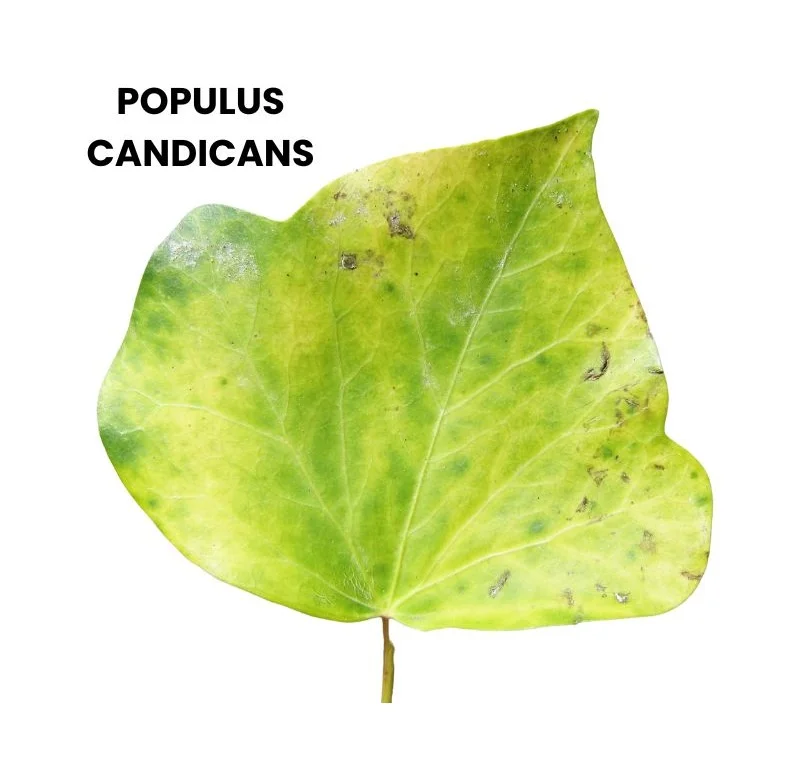Populus candicans, commonly known as Balm of Gilead, is a homeopathic remedy recognized for its efficacy in treating acute colds and respiratory conditions, particularly those involving hoarseness and loss of voice.
It also has notable effects on the skin and nervous system.

Table of Contents
ToggleDETAILED SOURCE INFORMATION
Scientific Classification
- Kingdom: Plantae
- Clade: Angiosperms
- Clade: Eudicots
- Order: Malpighiales
- Family: Salicaceae
- Genus: Populus
- Species: candicans
Botanical Description
- Appearance: Populus candicans is a deciduous tree that can grow up to 30 meters in height.
- It has a broad, spreading crown with leaves that are ovate to heart-shaped, and it produces catkins in the spring.
- Habitat: Native to North America, it is commonly found in moist environments such as riverbanks and wetlands.
Origin and Historical Facts
- Native Region: Populus candicans is native to North America, particularly in regions of Canada and the northern United States.
- Traditional Use: Indigenous peoples and early settlers used the buds and resin of the tree for their anti-inflammatory and soothing properties.
- It was commonly used in ointments for wounds, burns, and various skin conditions.
DRUG PATHOGENESIS
- Populus candicans affects the respiratory system, skin, and nervous system.
- It is particularly effective in managing acute colds, hoarseness, and skin insensitivity.
KEY CHARACTERISTICS AND SYMPTOMS
RESPIRATORY SYSTEM
- Acute Colds: Effective in treating acute colds with symptoms like hoarseness, dry cough, and burning sensations in the throat and nasal passages.
- Hoarseness and Aphonia: Known to rapidly improve hoarseness and loss of voice, often associated with dryness of the pharynx and larynx.
- Cough: Especially beneficial for coughs in children caused by postnasal drip and nasopharyngeal catarrh.
SKIN AND SENSORY SYMPTOMS
- General Insensibility: Patients often exhibit insensitivity to pain and pressure, particularly on the back and abdomen.
- Thickened, Horny Fingertips: Fingertips may become thickened and less sensitive to pinching and pricking.
HEAD AND NEUROLOGICAL SYMPTOMS
- Discussion of Symptoms: Patients tend to discuss their symptoms with others frequently.
- Hot Head with Cold Extremities: A notable symptom combination, often accompanied by cold-sores on the lips.
- Sensory Issues: Tongue feels thick and numb; burning irritation of the eyes, nose, mouth, and throat.
GENERAL SYMPTOMS
- Burning and Rawness: Patients experience burning and raw sensations in the chest and throat.
- Nervous Sensitivity: The remedy can alleviate general nervous sensitivity and discomfort.
MODALITIES
- Worse: Symptoms are aggravated by cold, damp weather and exposure to drafts.
- Better: Symptoms improve with warmth and rubbing or pounding, which are tolerated due to the warmth they produce.
WHAT ARE MODALITIES IN HOMOEOPATHY?
RELATIONSHIP WITH OTHER DRUGS
Compare
- Natrum Muriaticum: For cold-sores on lips and general cold symptoms.
- Coca: Known as an instantaneous voice-producer and effective in hoarseness and aphonia.
DOSE
- Form: Tincture.
- Potency: Typically used in low potencies for acute conditions.
Frequently Asked Questions
What conditions is Populus candicans used to treat?
- Populus candicans is used primarily for treating acute colds, respiratory conditions, hoarseness, aphonia, and skin insensitivity.
How does Populus candicans help with hoarseness?
- It has a rapid effect in improving hoarseness and loss of voice by addressing the dryness and burning sensations in the pharynx and larynx.
Is Populus candicans effective for cold-sores?
- Yes, it is effective in treating cold-sores, particularly when associated with general insensibility of the skin and a hot head with cold extremities.
Can Populus candicans be used for children?
- Yes, it is beneficial for treating coughs in children caused by nasopharyngeal catarrh and postnasal drip.
Glossary of Difficult Words
- Aphonia: Loss of the ability to speak.
- Catarrh: Inflammation of a mucous membrane, especially of the respiratory tract, with increased mucus production.
- Pharynx: The membrane-lined cavity behind the nose and mouth, connecting them to the esophagus.
- Larynx: The part of the respiratory tract containing the vocal cords, situated just below the pharynx.
Populus candicans (Balm of Gilead) is a versatile homeopathic remedy effective for treating acute respiratory conditions, hoarseness, and skin insensitivity, making it a valuable addition to homeopathic medicine.
